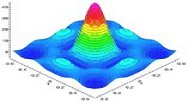
Polarized neutron diffraction image showing the
density of magnetic electrons in a strontium ruthenate.
Courtesy: US Government Spallation Neutron Source

New superconductor considered "Impossible"
22 June 1999....with update 25 April 2000
A Wellington, New Zealand, scientist and his German collaborator havediscovered a new type of superconductor which is, unexpectedly, both a magnet and asuperconductor. More than 40 years ago Russian theoretical physicist, ValeryGinzburg, proved that the two properties were incompatible and this has been theprevailing belief since. The new discovery refutes this belief.
Dr Jeff Tallon from Industrial Research, a Crown Research Institute, first made thematerial more than a year ago as a 'designer' superconductor intended to have exceptionalsuperconducting properties. Ten months passed before he and his colleague from Germany, DrChristian Bernhard, realized that the superconductor was also a magnet.
"This material is a curious combination of the expected and the unexpected, thepredictable and the unpredictable", said Dr Tallon. The discovery is being reportedthis month in the Physical Review, an American physical research journal.
The superconductor made from ruthenium and copper** is not the first magneticsuperconductor. That milestone was achieved in 1997 in an alloy of gold and indium whencooled to a few millionths of a degree above absolute zero. What is remarkable aboutTallon's magnetic superconductor is that it operates at 45° above absolute zero and, with modification, should reach 100°.
For several years scientists and computer manufacturers have been investigatingartificial materials made from films of magnetic material alternating with films of metalsor superconductors for use in data storage devices. The new superconductor already has such layering in its crystal structure. "This perhaps gives a new slanton cold storage", said Dr Tallon.
Dr Tallon emphasises the wider implications of this discovery:
"It is a classic example of the way in which science progresses – sometimesslowly through planned research and fine tuning, sometimes in quite unexpected quantumleaps through new discoveries.
As of 25 April, 2000, Dr. Tallon had reached a Tc of 58K with his revolutionary compound** and is optimistic that further refinements are possible to achieve an even higher Tc. Although, he states the synthesis of the required material is rapidly becoming more "tricky".
[**RuSr2(Gd,Eu,Sm)Cu2O8 or any parenthetical element partially substituted by Y.]
 Useful LINK on strontium-ruthenates
Useful LINK on strontium-ruthenates
 BACK to the "Atypical" page at Superconductors.ORG
BACK to the "Atypical" page at Superconductors.ORG
 BACK to the "News" page at Superconductors.ORG
BACK to the "News" page at Superconductors.ORG